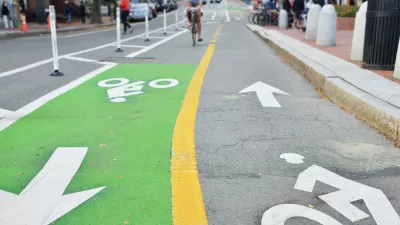Lee Epstein and Kaid Benfield pen a post on the importance of working rural landscapes to the sustainability agenda, which seems to be increasingly overlooked by smart growth advocates.
Although the authors acknowledge that recent attention has been paid to the, "strengthening of rural communities to make them more economically and environmentally resilient," they argue that what is missing from the sustainability and smart growth radar are the working landscapes in between rural towns.
By only focusing on the built-up rural areas, Epstein and Benfield note that planners and sustainability advocates miss the large swath of land under direct threat. "[T]he open, working lands around the town are often under direct threat or assault by the likes of debilitating and sprawling low density development even in the light of overall population loss (as in Pennsylvania), or by industries (such as mining or energy development) that sacrifice the long-term productive or natural character of a place even if they temporarily pump money into it."
The authors identify a number of proven and emerging strategies to prevent the loss of forest and farm land, but note that the development, coordination, and dispersal of such resources could be served by the involvement of governmental entities such as the innovative federal Partnership for Sustainable Communities.
"Their work would be strengthened by recognizing equally the importance of sustaining the working lands surrounding those communities that, if lost, will disconnect them from their heritage, culture, and in most places, a substantial portion of their economy."
FULL STORY: Let's link the working rural landscape to the sustainability agenda

Alabama: Trump Terminates Settlements for Black Communities Harmed By Raw Sewage
Trump deemed the landmark civil rights agreement “illegal DEI and environmental justice policy.”

Planetizen Federal Action Tracker
A weekly monitor of how Trump’s orders and actions are impacting planners and planning in America.

Why Should We Subsidize Public Transportation?
Many public transit agencies face financial stress due to rising costs, declining fare revenue, and declining subsidies. Transit advocates must provide a strong business case for increasing public transit funding.

Understanding Road Diets
An explainer from Momentum highlights the advantages of reducing vehicle lanes in favor of more bike, transit, and pedestrian infrastructure.

New California Law Regulates Warehouse Pollution
A new law tightens building and emissions regulations for large distribution warehouses to mitigate air pollution and traffic in surrounding communities.

Phoenix Announces Opening Date for Light Rail Extension
The South Central extension will connect South Phoenix to downtown and other major hubs starting on June 7.
Urban Design for Planners 1: Software Tools
This six-course series explores essential urban design concepts using open source software and equips planners with the tools they need to participate fully in the urban design process.
Planning for Universal Design
Learn the tools for implementing Universal Design in planning regulations.
Caltrans
Smith Gee Studio
Institute for Housing and Urban Development Studies (IHS)
City of Grandview
Harvard GSD Executive Education
Toledo-Lucas County Plan Commissions
Salt Lake City
NYU Wagner Graduate School of Public Service



























